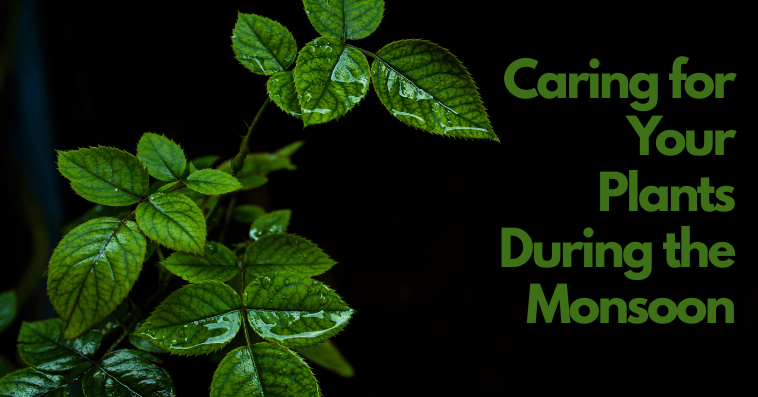The monsoon season brings much-needed relief from scorching summer heat—but for plants, it's a double-edged sword. While the rains replenish soil moisture and bring a burst of greenery, excessive water, low sunlight, and high humidity can also harm your plants. From fungal infections to root rot, improper care during monsoons can put your garden at risk.
Whether you’re growing houseplants or maintaining a lush balcony garden, this blog will help you master the art of monsoon plant care. Let’s dive into how to protect and nourish your plants during the rainy season and keep them thriving all the way through!
1. Understand the Impact of Monsoon on Plants
The monsoon season affects your plants in several ways:
Increased humidity can promote fungal growth.
Heavy rains may cause soil erosion, waterlogging, or root rot.
Lack of sunlight can stunt plant growth.
Wind and rainstorms can damage delicate stems and leaves.
That’s why monsoon gardening requires a different approach compared to summer or winter.
2. Ensure Proper Drainage
One of the biggest monsoon issues is overwatering—or rather, natural overwatering from rains.
Check all pots for adequate drainage holes.
Use well-draining soil mix—add cocopeat, sand, or perlite for better aeration.
Raise potted plants slightly using bricks or pot stands to prevent base clogging.
💡 Tip: Avoid using trays under pots during monsoon unless you're draining them daily.
3. Control the Watering Routine
During monsoon, nature does most of the watering, so hold off your watering can.
Touch the soil before watering. If it’s moist, skip watering.
For indoor plants, reduce the frequency significantly.
Early morning watering is better to reduce fungal risk.
🛑 Avoid watering late in the evening, as it creates damp, dark conditions—perfect for fungal infections.
4. Provide Adequate Air Circulation
High humidity can suffocate plant roots and invite mildew.
Space out pots to ensure air movement.
Prune dense foliage to allow better airflow.
Keep indoor plants near windows or doors to maintain ventilation.
🌿 Proper circulation helps dry out moisture and keeps diseases at bay.
5. Protect Plants from Heavy Rainfall
Too much rain can damage delicate plants.
Shift potted plants to sheltered areas like balconies or patios.
Use temporary plastic covers or green netting for garden beds.
For terrace gardens, install shade nets or polyhouses to control exposure.
🌱 Delicate herbs, young saplings, and succulents are particularly vulnerable—shield them!
6. Watch Out for Pests and Fungal Diseases
Monsoon is the breeding season for many plant pests and fungi.
Inspect plants regularly for mealybugs, aphids, slugs, and snails.
Use organic pest control solutions like neem oil spray or diluted soap water.
Remove yellowing leaves and dead branches to prevent fungal spread.
Sprinkle cinnamon powder or turmeric on affected soil to treat fungus naturally.
⚠️ Early detection is key. Don’t let small infestations grow into big problems.
7. Clean Leaves and Surroundings
Dust, mud, and debris collect easily during rains.
Gently wipe plant leaves with a damp cloth to prevent clogging of pores.
Remove fallen leaves, stagnant water, and weeds around plant bases.
Clean the pot rims and trays to avoid insect breeding.
🌿 Clean plants = happy, breathing plants!
8. Prune and Trim Your Plants
Heavy rains can make plants top-heavy and leggy. Pruning helps:
Shape the plant and encourage healthy regrowth.
Remove damaged or diseased parts.
Improve light penetration and air flow.
💡 Trim only with sterilized pruning shears to avoid transferring infections.
9. Feed Them Right
Monsoon rains may wash away soil nutrients.
Use organic fertilizers like compost or vermicompost every 2–3 weeks.
Avoid over-fertilizing—it can leach into already moist soil and burn roots.
Add mulch (dry leaves, bark, or coconut husk) to preserve nutrients and regulate moisture.
🌾 A balanced feed ensures lush foliage and strong roots despite weather stress.
10. Make the Most of Sunlight When It Appears
Sunlight is rare during overcast monsoon days.
Shift sun-loving plants to spots with maximum exposure when the sun is out.
Rotate your pots regularly for even growth.
Consider installing portable grow lights if the weather remains gloomy for long.
🌤️ Sunshine boosts photosynthesis and helps dry off excess moisture.
Pro Tips for Specific Plants
Succulents & Cacti: Keep them indoors and water only when soil is bone dry.
Herbs (mint, basil, coriander): Ensure daily air circulation and don’t let them stay damp.
Ornamental plants (coleus, ferns): Trim regularly and keep under shade.
Where to Buy Healthy, Monsoon-Ready Plants Online?
Now that you’re ready to care for your green buddies, why not add some more to your collection?
Visit PaudheWale to explore a wide range of monsoon-suitable indoor and outdoor plants, gardening tools, and organic fertilizers—all delivered fresh to your doorstep.
✅ Why Choose PaudheWale?
Carefully packed, pest-free plants
Affordable prices & combo packs
Expert tips with every order
Fast delivery across India
Eco-friendly packaging
💚 Make your garden monsoon-proof — shop now at PaudheWale and keep your plants smiling, rain or shine!

